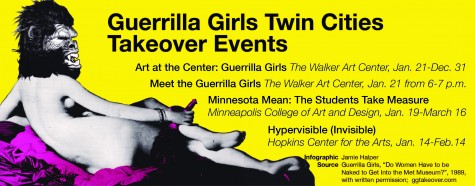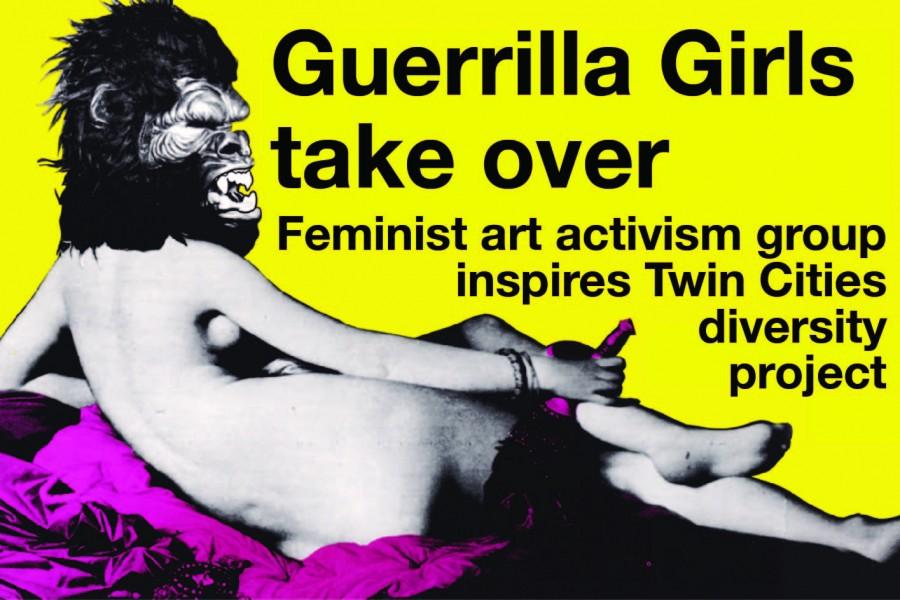Guerrilla Girls take over
Feminist art activism group inspires Twin Cities diversity project

The Minneapolis Institute of Art’s American and European collections contain 420 pieces of art, according to a recent evaluation of the collection. Women created only nine of those pieces. But, that’s about to change.
The Twin Cities art community plans to celebrate the work of feminist art activism group, the Guerrilla Girls, through a series of events and exhibitions this year.
According to Nicole Soukup, artist liaison for The Minneapolis Institute of Art (Mia), as part of the project, the Guerrilla Girls recently evaluated the museum’s collection on its degree of diversity.
“It felt really fitting, especially following our 100th year, to have the Guerrilla Girls come in and really look at the collection with fresh eyes and evaluate our diversity,” Soukup said. “Sometimes it’s hard to see what outsiders can see when you’re so close to a collection like this.”
Soukup said based on the museum’s own efforts and the Guerrilla Girls’ evaluation, the museum plans to expand the diversity of its collection during the next few years.
“We’re looking at adding more women and more artists of diverse backgrounds to our exhibition line-up,” Soukup said. “We have a very diverse community in Minneapolis and in Minnesota, and we’re trying to actively look for artists that accurately and appropriately fill in those parts of our collection.”
Soukup said this includes looking for art from contemporary Native American artists and local Hmong artists, in addition to expanding gender representation.
Freshman Ifraah Dhegadub said she thinks it is necessary to increase diversity in museums to reflect the community and its interests.
“I think that it’s not really fair that there’s a certain group of art that’s in museums and that’s it’s not the most diverse,” Dhegadub said. “Diverse people attend museums, and there should be diverse works there.”
The Guerrilla Girls work anonymously, wearing gorilla masks when making public appearances. A member of the Guerrilla Girls, who goes by Frida Kahlo in keeping with the group’s tradition of using pseudonyms, said there have been improvements in the diversity of the art world throughout their years of advocacy work.
“I think that no one any longer could say that women, artists of color, (transgender) people, gay, lesbian, bisexuals, that those marginalized groups are not making art good enough to be put in a museum,” Kahlo said. “Twenty or 30 years ago, people were actually saying that.”
Despite this progress, Kahlo said much more must be done in terms of diversifying representation in art galleries and museums, including examining the ethics of how museums build their collections.
“If you look at the auction results, you’ll see that women, artists of color and (transgender) people just don’t have the same economic rewards that white men get,” Kahlo said. “As long as the price of art has a great influence on what art museums collect, they’re just going to mirror everything that’s wrong with the larger culture.”
Kahlo said the issues of the art world stem from those that impact broader society.
“A lot of what’s wrong with the world in general — politically, socially and economically — is really wrong with the art world, too,” Kahlo said. “The art world has become a kind of investment tool for the super-wealthy.”
Soukup said diversifying the Mia’s collection makes it more relatable and accessible for students.
“Diversity creates a direct personal connection,” Soukup said. “I think it’s really easy to walk into the museum and see Van Goghs and Monets and Renoirs and expect that’s high art, but if we’re talking about it at the individual level, it’s really apparent that those artists don’t look like you or that those are artists that are kind of removed from you.”
Dhegadub said when museums fail to include diverse works in their collections, it makes her less interested in visiting museums and viewing art.
“(Only seeing men’s art) makes me not want to see art, but if there were more diverse people like women or people of color, I’d be more interested in going to see art,” Dhegadub said.
However, the Mia isn’t the only Twin Cities museum involved in the Guerrilla Girls Takeover. The Walker Art Center will host a year-long exhibition of its collection of the Guerrilla Girls’ works starting Jan. 21, according to Misa Jeffereis, the curator of The Walker’s Guerrilla Girls exhibit.
Jeffereis said the museum’s display includes a selection of images from its extensive Guerrilla Girls collection.
“We brought their entire collection of posters into our permanent collection so that’s what these 30 posters are from — their entire collection of about 88 over the years,” Jeffereis said.
The Guerrilla Girls will attend the opening night of this exhibition Jan. 21 from 6-7 p.m., according to Jeffereis. The appearance is in conjunction with a number of Guerrilla Girls visits in the coming months to do workshops, including some specifically for teens, and speaking engagements.
“I hope that long-term engagement with the community, with the teens and students, will encourage (students) to keep up their work,” Jeffereis said.
Dhegadub said seeing the Guerrilla Girls in person would motivate student advocacy efforts.
“I feel like it’d be cool to see them and get inspiration from them to do something like this, too,” Dhegadub said.
Outside the local museum community’s involvement in this initiative, the Minneapolis College of Art and Design (MCAD) was instrumental in bringing this project to the Twin Cities, according to Kerry Moran, MCAD’s director of gallery and exhibition programs.
Morgan said MCAD’s involvement in the program goes beyond simply discussing the Guerrilla Girls and their works. MCAD also plans to focus on how its student artists can become art-based advocates for social issues of importance to them, she said.
“It’s not just about the Guerrilla Girls — it’s about what comes after,” Morgan said. “The idea is that we’re going to use them as a platform to launch our own initiative and focus on artists and organizations that are all about raising people’s consciousness about the inequities of the world at large.”
According to Morgan, MCAD will host a number of gallery exhibitions featuring MCAD student art on different topics of advocacy as part of its participation in the takeover.
“We have a show that’s called ‘Minnesota Mean: Students Take Measure’ and it’s featuring work only by our current students,” Morgan said. “You’re going to see in this exhibition a wide range of ideas and materials and final products. (Students) took on subjects such as animal cruelty, racism in arts schools, our obsession with the pharmaceutical industry and another group did gun violence.”
Kahlo said students are the key to diversifying the future of the art world and establishing a culture of equality.
“Young people are more attuned to the need for change. I believe that young people now think more about diversity than adults do, and certainly more than people in power,” Kahlo said. “It’s really crucial for young people to act on their beliefs and stand up for what they believe in and educate for change in institutions in the arts community.”
